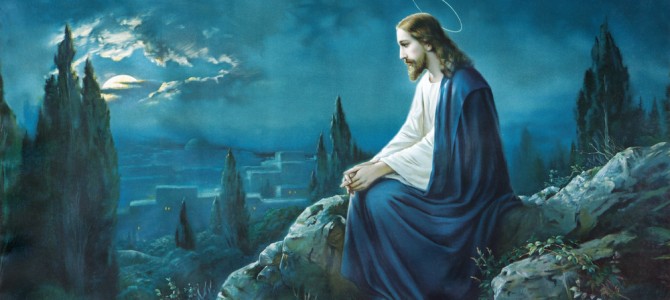
When “Killing Jesus” premieres on the National Geographic Channel this coming Sunday (March 29), it will mark a departure from previous Jesus films in at least three ways.
First, the film will adopt a respectfully agnostic position on the miracles: Produced by Ridley Scott (who directed the similarly agnostic “Exodus: Gods and Kings” just a few months ago) and based on the book by Bill O’Reilly and Martin Dugard, the film will begin with prophecies and Wise Men from the East, and it will end with an empty tomb, but the actual wonders performed by Jesus will be left open to interpretation. Second, the film will focus on Jesus’ family, including his brother James, more than most previous films have done.
But most significantly of all, perhaps: for the first time ever, the actor playing Jesus in a major English-language film—Haaz Sleiman, born in the United Arab Emirates and raised in Lebanon—will be someone from the Middle East, just like Jesus himself.
The Rise in Ethnic Authenticity
For centuries, Western artists, especially those hailing from northern Europe, have imagined a Jesus who looks more or less like them: blue eyes, hair that falls somewhere between blonde and light brown, and so on. This image of Jesus has carried over into popular films: actors like Jeffrey Hunter (in 1961’s “King of Kings”) and Robert Powell (in 1977’s “Jesus of Nazareth”) were reportedly cast as Jesus for the piercing intensity of their eyes—eyes which happened to be blue—and later filmmakers like Martin Scorsese (1988’s “The Last Temptation of Christ”) perpetuated the stereotype because they wanted to subvert that image instead of replacing it altogether.
More recently, however, filmmakers have been looking for alternatives to the stereotype, and you can see this process at work already in Mel Gibson’s “The Passion of the Christ” (2004). For all the controversy stirred up by that film, Gibson wanted it to be as “historically accurate” as possible, and to that end, he not only had the actors speak all their dialogue in Latin and Aramaic, he also had actor James Caviezel made up to look more Semitic, even going so far as to turn Caviezel’s blue eyes brown using digital effects.
Then came “The Nativity Story” (2006), directed by Catherine Hardwicke, which went out of its way to cast actors who either came from the Middle East or could at least pass for characters who did. The Virgin Mary was played by Maori Keisha Castle-Hughes and Joseph was played by Oscar Isaac, an American actor of Cuban and Guatemalan descent; but many of their relatives and neighbours—including Mary’s parents and her cousin Elizabeth—were played by Palestinians and Iranians, and the angel Gabriel was played by Alexander Siddig, a British actor of Sudanese descent on his father’s side.
More recently, the Lumo Project, which is developing word-for-word adaptations of all four gospels—the first one, “The Gospel of John,” premiered on Netflix last year—cast Selva Rasalingam, who is part Tamil, as Jesus. And rumour has it that Cliff Curtis, the Maori actor who played Castle-Hughes’ father in “Whale Rider,” may be playing Jesus himself in “Clavius,” an upcoming film about a Roman centurion who investigates reports of the resurrection. (Rasalingam has a part in that film, too, as one of the apostles named James.)
Middle Eastern Filmmakers Get In on the Action
Meanwhile, as all this has been going on, filmmakers within the Middle East itself have been mounting their own productions—sometimes successfully, sometimes not.
Iranian cinema, in particular, has produced a number of films over the last decade or two that are based on biblical figures such as Abraham, Joseph, and Solomon, but because these films are produced with the approval of the Iranian government, they take the Koran as their primary source material rather than the Bible. Thus, for example, “Abraham, the Friend of God” (2008) concludes with Abraham and Ishmael together building the Kaaba, the holiest site in Islam.
One early entry in this genre was “Saint Mary” (released in 1997 or 2002, depending on which source you believe). Directed by Shahriar Bahrani, this film tells the story of Jesus’ mother, from her own birth to the birth of her son, and while some of its plot points—such as Mary growing up in the Jerusalem temple—can be traced to apocryphal Christian literature, others, such as her claim to have been visited in a vision by the future mother of the “last prophet,” clearly reflect Muslim beliefs. The film also makes a point of emphasizing that the Iranians’ ancient forebears believed in a single God long before they were Muslim: the three Wise Men are all identified as Persians who believe in Ahura Mazda, and they say that the birth of the Messiah will be a blessing to monotheists from all over the world.
This was followed several years later by “Jesus, the Spirit of God” (2007), also known as “The Messiah,” which was later expanded into a 20-episode TV series. Directed by Nader Talebzadeh, the Jesus of this film repeatedly insists that he is not divine, offends the Jews by saying it was Ishmael rather than Isaac that Abraham almost sacrificed, and predicts the coming of a “Comforter” (i.e. Mohammed) who “will remind everyone of what I have taught and will bear testimony to the truth of my teachings when it has gone astray.” Finally, in keeping with the Muslim belief that God would not have allowed Jesus to suffer the horrors of crucifixion, and taking its cue from the so-called Gospel of Barnabas, this film shows Jesus being taken up into heaven before the authorities can arrest him, and Judas being crucified in Jesus’ place.
Jesus Films In Islamic Cultures
Films about Jesus and other biblical figures are permitted in Iran because Shi’ite Islam does not frown upon depictions of the prophets the way that Sunni Islam often does. But outside of Iran, it has been more difficult to make a movie about Jesus in the Middle East.
It was not always thus: The Arabic life-of-Jesus movie “The Life and Passion of the Christ” was produced by an Egyptian film company way back in 1939, and the film was reportedly shown in theatres at Christmas and Easter every year until it was banned in the 1970s. But it is difficult to find much information about the film, and it has apparently been so thoroughly blocked from the collective cultural memory of that region that filmmakers who now try to make Arabic films about Jesus sometimes claim that their films are the first to be made in that language.
And Arabic filmmakers certainly have been trying in recent years to make movies about Jesus in their own language, and in ways that would celebrate the story’s connection to their homelands.
In 2006, Egyptian filmmakers Mohammed Ashoub, a Muslim producer, and Fayez Ghali, a Christian screenwriter, announced their intention to make a movie about Jesus in Arabic; four years later, they tapped Ahmed Maher, a Muslim, to direct the film. Maher said he wanted to make the film partly to shine a light on the country’s positive history at a time when it was being associated with terrorism. “It is important for the West to understand that Egypt, which produced [al-Qaeda leader] Ayman El-Zawahri and [9/11 terrorist] Mohamed Atta, is itself the country that embraced Christ the infant when no one else would,” he said.
Meanwhile, in 2009, Lebanese director Samir Habchi announced that he was going to direct the first Arabic movie about Jesus. Called “The Resurrected,” he planned to shoot it in many of the actual locations that Jesus is said to have visited, including the Lebanese cities of Qana, where Jesus may have performed his first miracle, and Tyre, where Jesus was persuaded to heal a Gentile woman’s daughter after he initially rebuffed her.
Neither of these films, however, seem to have been made in the end. They do not show up on the filmmakers’ Internet Movie Database pages, and no other information about them seems to exist. Sometimes movies fall apart in pre-production; sometimes overly ambitious producers go public with their plans before they’re ready to act on them. But in the case of the Egyptian film, at least, the filmmakers also received strong opposition from Al Azhar, the top Sunni institution in Egypt, which said it was forbidden to make images of Jesus.
One new Arabic film about Jesus was made in the end, though: “The Savior” (2013), directed by Palestinian filmmaker Robert Savo and shot entirely in Jordan and Bulgaria.
While “The Savior” does include some details that are probably unique within this genre—such as a supernatural light that descends on Mary’s womb while she’s sleeping sometime after the Annunciation—the film is a relatively straightforward adaptation of Luke’s gospel, with bits of Matthew and John thrown in for good measure. And while the film was financed by Christians from the United States and other countries, the dialogue is all in Arabic, and the actors—at least some of whom are Muslim—are all from the Middle East, as well. A booklet promoting the film, and a video featuring interviews with the actors, assert that this is the first film to tell the story of Jesus featuring Arabic actors speaking Arabic dialogue.
‘Killing Jesus’ Marries These Two Trends
So, “Killing Jesus” may represent a confluence of two streams in recent film history: a greater emphasis on historical accuracy in American films, and greater opportunities for Middle Eastern actors to play characters who appear in both the Bible and the Koran.
And these two streams may run together even more in years to come: The ABC network has commissioned a pilot for a possible TV series about Saul and David called “Of Kings and Prophets.” It counts Iranian-American writer Reza Aslan among its producers, and the cast includes Mohammad Bakri (an Israeli Arab who played Herod Antipas in “The Savior”) as the prophet Samuel, and “Killing Jesus’s” own Haaz Sleiman as Saul’s son Jonathan.
These stories originated in the Middle East. And now, actors and filmmakers from the Middle East are playing a greater part than ever in getting these stories told.









